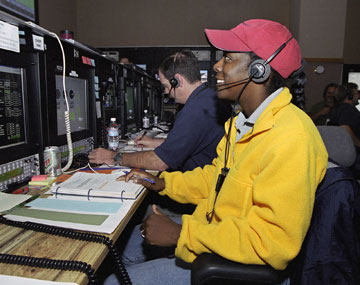Release: 04-60
 As a young student one of Laurie Marshall’s first science experiments was observing the moon throughout the night. The experience convinced her it would be a great adventure to be a part of space exploration. Today, she is a leader on a project that could help make space exploration easier and less expensive.
As a young student one of Laurie Marshall’s first science experiments was observing the moon throughout the night. The experience convinced her it would be a great adventure to be a part of space exploration. Today, she is a leader on a project that could help make space exploration easier and less expensive.
Image left: Laurie Marshall, at work as NASA Dryden’s chief engineer for the third flight of the hypersonic X-43A research vehicle. NASA Photo
Marshall was the chief engineer for the third flight of the hypersonic X-43A research vehicle at NASA’s Dryden Flight Research Center, Edwards Air Force Base, Calif.
Prior to her assignment, Marshall was launch vehicle chief engineer for the X-43A. The X-43A is a 12-foot-long, autonomous aircraft. It demonstrates an air-breathing engine called a scramjet. The vehicle broke the speed record for an air-breathing engine in March. It broke its own record by flying at nearly 10 times the speed of sound on Nov. 16.
Marshall has served in various experimental and science positions at Dryden. She was the principal investigator on the Advanced L-Probe Air Data Integration experiment. It was flown on the F-18 Systems Research Aircraft that used air pressure to determine angles of attack and sideslip in addition to the traditional air data measurements. She was an aerospace researcher on the F-16XL ship 2 Supersonic Laminar Flow project. She was also involved in analysis of Space Shuttle maneuvers that resulted in expanding the aeronautical database.
Early in her career, Marshall decided the best way to learn about different fields within aerospace engineering was by personally experiencing as many as possible. She began her pursuit as a student engineer in the Engineering Bureau of the Los Angeles City Department of Airports in 1989.
In 1990, she was an aerodynamics research assistant in the Minority Opportunities in Research Engineering program at the University of California at Davis. She then interned in 1990 as a technical staff undergraduate in the Structural Technology Division at the Aerospace Corporation.
Her NASA career began with a 1992 internship in Dryden’s Aerodynamics Branch, which led to her working full-time for NASA after graduation, beginning in 1993.
Although not carrying on the family business of practicing law, Marshall argues that flying is in her blood. She grew up around and flying in airplanes. Her father got his pilot’s license the year she was born; therefore, she was destined to work with aircraft. And today, Laurie is also a private pilot with an instrument rating.
Marshall chose to work at NASA because she felt the agency was always working cutting edge research, and she was also very interested in the idea of space exploration. Marshall graduated from the University of California at Davis with a bachelor of science degree in aeronautical and mechanical engineering. She earned an Engineer-in-Training license in 1994. She received a master of science degree in mechanical engineering in 1998 from California State University at Fresno.
Marshall’s advice to young people: “One thing I’ve learned is that you should never let anyone tell you that you can’t do something. Even if it seems difficult, stay with it if it’s something you really want to do.”
Media organizations interested in interviewing Marshall or desiring photos of her should contact Beth Hagenauer at 661/276-7960 or the NASA Dryden public affairs office at 661/276-3449.
For further information about the X-43A and NASA’s Hyper-X hypersonic research program, log on to: https://www.nasa.gov/missions/research/x43-main.html.
-NASA-
NASA Dryden Engineer Laurie Marshall Explores Hypersonic Flight




























